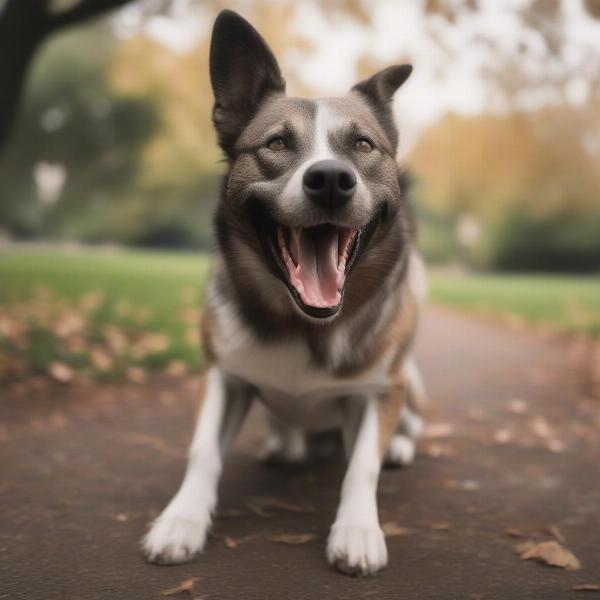A dog’s hot head can be a cause for concern for many owners. While a slightly warm head isn’t always a sign of illness, it’s important to understand what’s considered normal and when a warm head might indicate a more serious underlying issue. This article will explore the various reasons why a dog’s head might feel hot, how to assess your dog’s overall health, and when to seek veterinary attention.
A slightly elevated head temperature in dogs can be attributed to several factors, including ambient temperature, recent physical activity, and even emotional state. However, a significantly hot head, particularly when accompanied by other symptoms, can be a sign of fever, heatstroke, or other health concerns.
Determining a Normal Dog Head Temperature
Unlike humans, dogs don’t sweat through their skin. They primarily regulate their body temperature through panting and sweating through their paw pads. Therefore, a dog’s head may naturally feel warmer than other parts of their body.
It’s important to remember that touching your dog’s head isn’t a reliable way to determine if they have a fever. A rectal thermometer provides the most accurate reading. A normal rectal temperature for a dog ranges from 100.5°F to 102.5°F (38.1°C to 39.2°C). Anything above 103°F (39.4°C) is considered a fever and warrants veterinary attention.
Common Causes of a Hot Dog Head
Several factors can contribute to a dog’s head feeling warmer than usual. Some common causes include:
- Environmental temperature: On a hot day, a dog’s head may feel warmer due to increased exposure to sunlight and heat.
- Exercise: Physical activity increases body temperature. A dog’s head might feel warm after a run or playtime.
- Excitement or stress: Emotional states can also influence body temperature. An excited or stressed dog might have a slightly warmer head.
- Fever: A fever is a sign that the body is fighting an infection or illness. dogs head hot can be a symptom of a fever.
- Heatstroke: Heatstroke is a life-threatening condition that occurs when a dog’s body temperature rises dangerously high.
 Dog Panting After Exercise
Dog Panting After Exercise
Recognizing Signs of Heatstroke
Heatstroke is a serious medical emergency. If your dog’s head feels excessively hot and they exhibit any of the following symptoms, seek immediate veterinary care:
- Excessive panting or difficulty breathing
- Bright red gums
- Vomiting or diarrhea
- Weakness or collapse
- Seizures
When to Seek Veterinary Attention
While a slightly warm head isn’t always a cause for alarm, it’s important to monitor your dog for any other accompanying symptoms. why is my dogs head hot If your dog’s head feels excessively hot, or if they display any signs of illness, such as lethargy, loss of appetite, vomiting, or diarrhea, consult your veterinarian as soon as possible.
Preventing Overheating in Dogs
There are several steps you can take to prevent your dog from overheating, especially during warmer months:
- Provide plenty of fresh water.
- Avoid strenuous exercise during the hottest parts of the day.
- Offer shaded areas for your dog to rest.
- Never leave your dog unattended in a parked car.
Conclusion
A dog’s hot head can be a normal occurrence or a sign of a more serious issue. By understanding the potential causes and recognizing the symptoms of heatstroke, you can take appropriate action to ensure your dog’s well-being. top of dogs head is hot can sometimes indicate an issue, so remember to monitor your dog’s overall health and consult your veterinarian if you have any concerns.
FAQ
- Is a dog’s head naturally warmer than other parts of its body? Yes, a dog’s head can naturally feel warmer due to its lack of sweat glands on most of its body.
- What is the normal rectal temperature for a dog? The normal range is 100.5°F to 102.5°F (38.1°C to 39.2°C).
- When should I be concerned about a dog’s hot head? If the head is excessively hot, or if accompanied by other symptoms like lethargy, vomiting, or difficulty breathing.
- How can I prevent my dog from overheating? Provide ample water, shade, avoid strenuous exercise in the heat, and never leave them in a parked car.
- What should I do if I suspect my dog has heatstroke? Seek immediate veterinary attention. old dog hot head requires extra caution in warm weather.
About ILM Dog
ILM Dog is your premier online resource for comprehensive dog care information, covering everything from breed selection and training to health, nutrition, and grooming. We aim to empower dog owners worldwide with expert advice and practical tips to ensure the happiness and well-being of their canine companions. Our expertise covers a range of topics, including dog breeds and selection, health and medical care, training and behavior, nutrition and feeding, grooming and hygiene, and products and accessories. For any inquiries, please contact us via email at [email protected] or call us at +44 20-3965-8624. Visit ILM Dog today for reliable information and resources to support you in providing the best possible care for your furry friend!